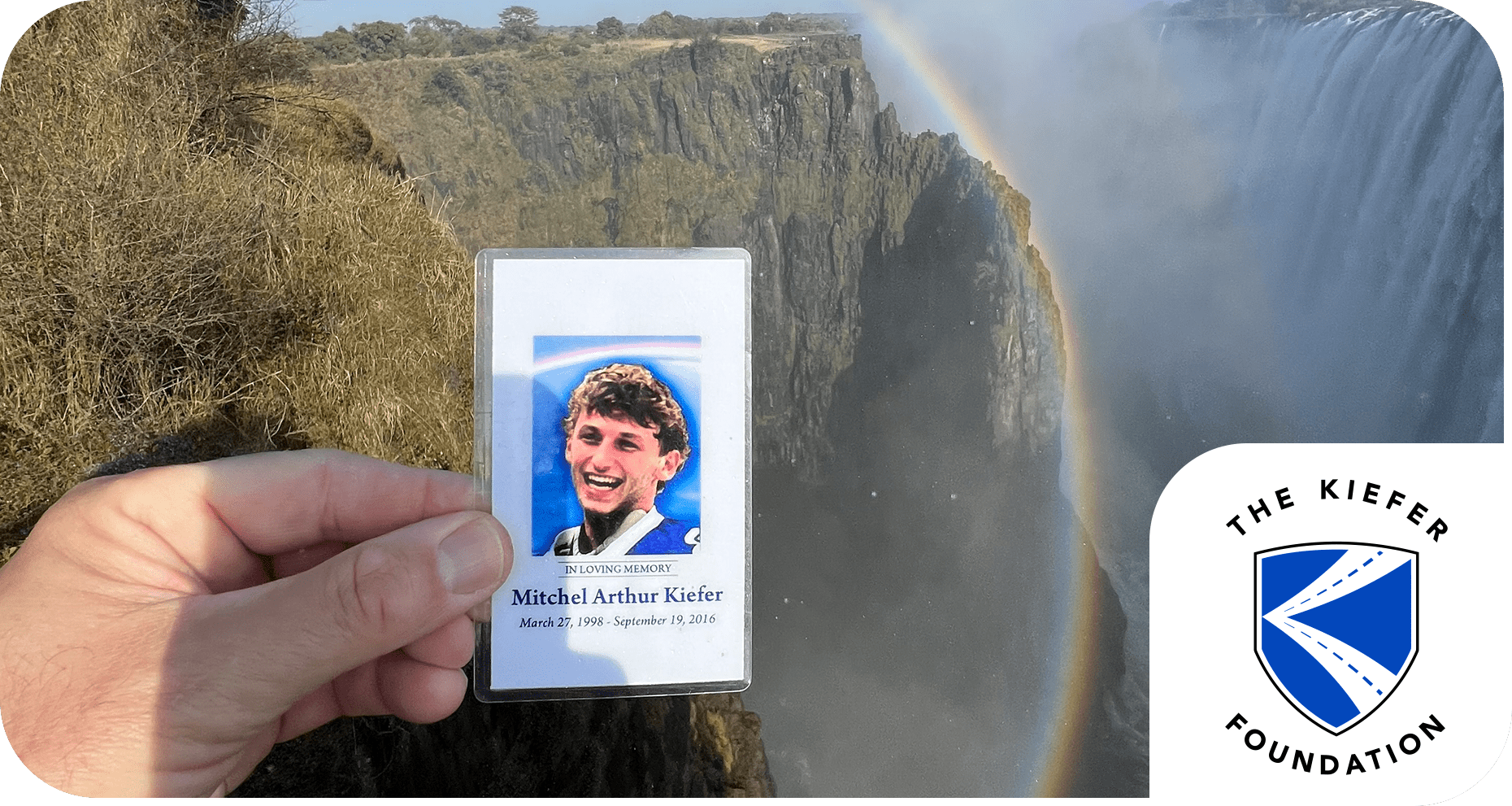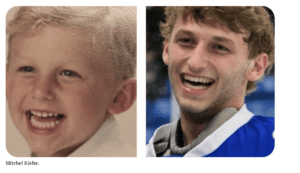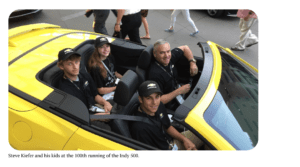How The Kiefer Foundation is driving behavior change through three pillars — awareness, technology, and hands-free legislation

After spending four decades in the automotive industry, rising from a young engineering student to the Senior Vice President of General Motors International Operations, Steve Kiefer pivoted to a cause personal to him.
In the wake of a tragic loss, he committed himself to fighting distracted driving through three pillars: raising awareness, leveraging technology, and shaping legislation. In this conversation, Steve shares the story behind founding The Kiefer Foundation, the progress they’ve made, and the ongoing efforts to make roads safer for everyone.
Our conversation has been edited for clarity and brevity.
CMT: Hi Steve. Thanks for joining me today. Can you share your story with us?
Steve: The Kiefer Foundation was founded in 2016, following the death of my son Mitchel. Mitchel was killed by a distracted driver on September 19th, 2016. He was in his first month of school as a young college student at Michigan State University.
Mitchel was driving up on a beautiful Monday morning. Traffic slowed down. He slowed down. Unfortunately, the young lady behind him did not. She was on her phone and she rear-ended Mitchel and drove him across a very narrow strip of grass into oncoming traffic. He was hit by a truck and killed instantly.
When this happened to our family, we immediately had to decide what to do with our grief. We sort of huddled together as a family and said we can let this define us and destroy us or we can use this to try to bring some good to the world and hopefully save lives in Mitchel’s honor. We founded The Kiefer Foundation in the weeks afterward with a mission to bring an end to distracted driving and all associated crashes and fatalities. 
Mitchel was an amazing young man at 18 and he always had a dream of changing the world. We decided we were going to change the world in his memory by bringing the initiative of ending distracted driving to the world and hopefully make the roads of the world a safer place.
CMT: I see that the Kiefer Foundation focuses on three specific pillars to stop distracted driving: awareness, technology, and legislation. How do you focus on spreading awareness?
Steve: After a few months, we decided to put some structure to our organization. Awareness was the first pillar we focused on. We quickly realized how large this problem was. The data says nine to ten people die each day by distracted drivers in this country. But when you look into it and talk to law enforcement, you know it’s much worse. We believe the number is closer to 50 people killed per day by distracted drivers.
It’s about creating some understanding of that. When you tell someone 50 people will die today because of a distracted driver, it’s shocking. That was the start of our awareness campaign and other people helped in that effort. The Michigan Governor was kind enough to dedicate the road where Mitchel was killed to Mitchel. It’s now known as the Mitchel Kiefer Distracted Driver Awareness Highway. 
We also dedicated the ice rink where Mitchel and the Detroit Catholic Central Team won the state championship in 2016, just months before Mitchel was killed. That ice rink is now known as the Mitchel Kiefer Memorial Ice Rink.
It’s about Mitchel, but it’s much more about distracted driving. Throughout that ice rink, you see all kinds of messages and signs about safe driving. I can’t tell you how many times I received messages from people who tell me they’ve shared Mitchel’s story with young drivers, future drivers, and their family members. Mitchel’s death is a hard thing for us to talk about. But when we travel the country and even travel the world, we tell Mitchel’s story, as painful as it is, because we know it does create awareness.
CMT: Is that where the idea for the “Just Drive” campaign came from?
Steve: Yes. These victim stories are very impactful. So, a couple of years ago, we launched a new campaign called “Just Drive.” We did that with the help of Tom Brady for the Fourth of July weekend two years ago. We looked for a very simple phrase. When you’re behind the wheel, put your phones away and just drive.
We think that it’s really gaining some momentum. We’ve got a number of celebrity influencers who have created messages for us, and we’ve really put those messages out. Awareness is a very important first pillar but it isn’t enough.
CMT: How is The Kiefer Foundation advancing its technology pillar initiatives?

Steve: Distracted driving has gotten much worse since the cell phone has become predominant in people’s lives. We often say the cell phone is the root of the problem, but it can be part of the solution.
We’re so pleased to partner with Cambridge Mobile Telematics on the work this company is doing because we do believe that safe driving apps are one of the elements that can actually change behavior and make the roads safer. There are a number of other technologies that we’re trying to promote as well like the “Do Not Disturb While Driving” feature on your phone. We want to make sure people turn these tools on.
There’s a lot of technology that we think can be a solution to this problem in addition to some infrastructure solutions. In Mitchel’s memory, we worked with the Michigan Department of Transportation and installed cable guardrails. At the point of Mitchel’s crash, a cable guardrail would have stopped him from going into oncoming traffic and saved his life. This is a different type of technology that we’ve been promoting to help in the event that a crash does happen.
CMT: The third pillar is legislation. How are the efforts progressing to get each state to adopt the hands-free laws?
Steve: It’s very difficult to change behavior and to force technology when there’s no legislation that requires it. There’s a foundational piece in this where we have to implement hands-free laws in every state that make it illegal to hold the phone while driving. It’s not perfect but it definitely has been effective. We now have hands-free laws in place in 29 states and in every state where these laws are implemented, we see anywhere from 10-20% reduction in crashes and in fatalities and even insurance rates come down.
We know that these laws work. When they’re coupled with really strong messaging or awareness campaigns and strong enforcement, they’re really able to push a 20% reduction in crashes. The three pillars of awareness, technology, and legislation are all interdependent and all work closely together.
CMT: What is The Kiefer Foundation’s wishlist in the next 12-18 months?
Steve: I would say the top priority for us is continuing this journey of getting every state to implement these hands-free laws. We’re hopeful to get Pennsylvania done this year and that would be our 30th state. We believe at some point the argument will be so compelling when you have more than half of the country that’s already adopted this and there are proven results. We’re hoping there will be a tipping point and all the other states will fall into place, but so far it’s not proving to be that way.
Second, in the states that already have the legislation, it’s not over once you get the law in place. We see a lot of data that says there is a reduction in crashes and a reduction in phone use immediately but then it comes back if there’s no enforcement or minimal PSAs and awareness. We have to keep doubling down on all these states to continue to bring the crash rate down. Until we see in this country a reduction in the crash rates and fatality rates our work is never going to be over.
CMT: Having been personally impacted by distracted driving, what message would you like to share with others about the consequences of that dangerous decision?
Steve: I was probably one of the worst offenders before this happened to me. I can admit that I thought I was a safe distracted driver. I would drive with my knee, drink coffee in one hand, and keep my phone out in front of me looking at the road, glancing at my phone, because I thought I could do it safely.
I hate to think that people have to have a personal story before they change their behavior. I just ask that everyone who reads this article to consider this: Just really stop and think about the loss of a loved one or a life-long injury for yourself or a loved one. It’s not worth that one quick text, Snapchat, or video that you have to watch. It can definitely wait. And, as we say, when behind the wheel, just drive.